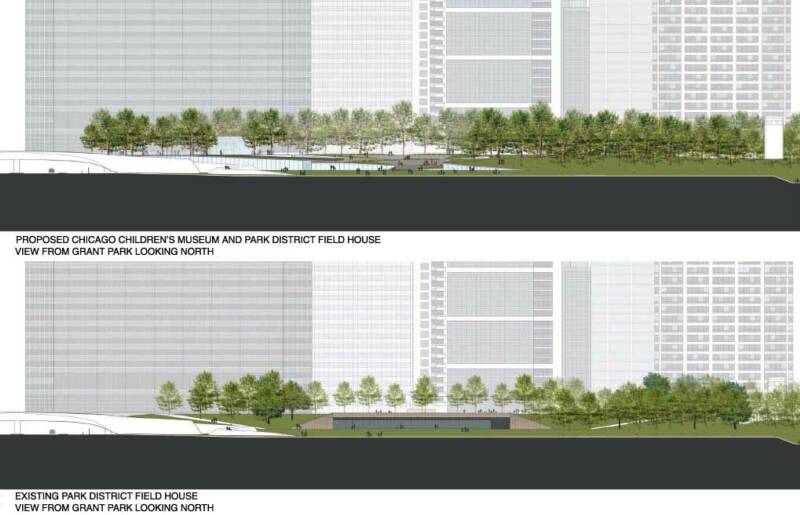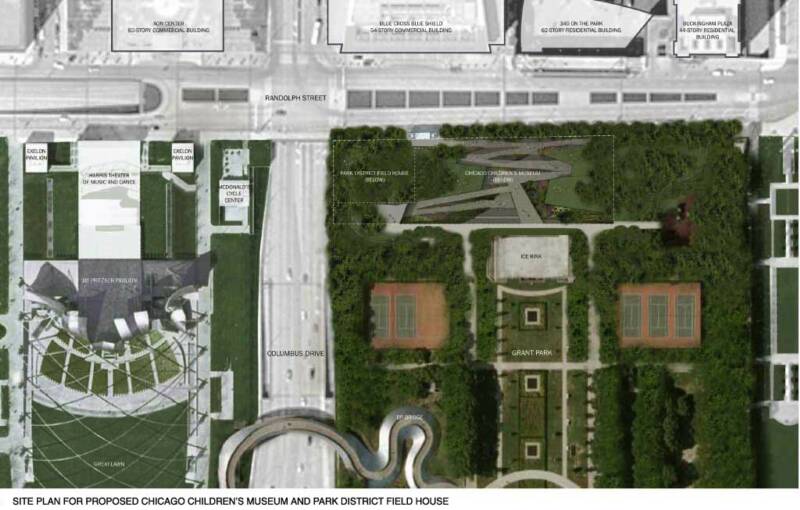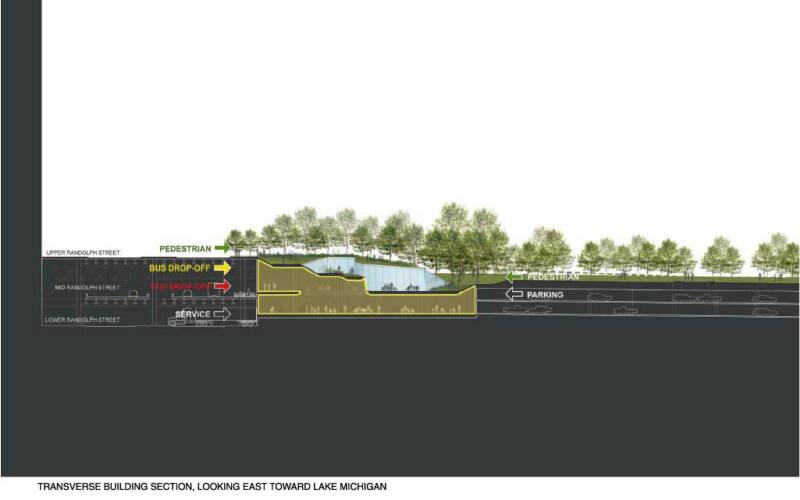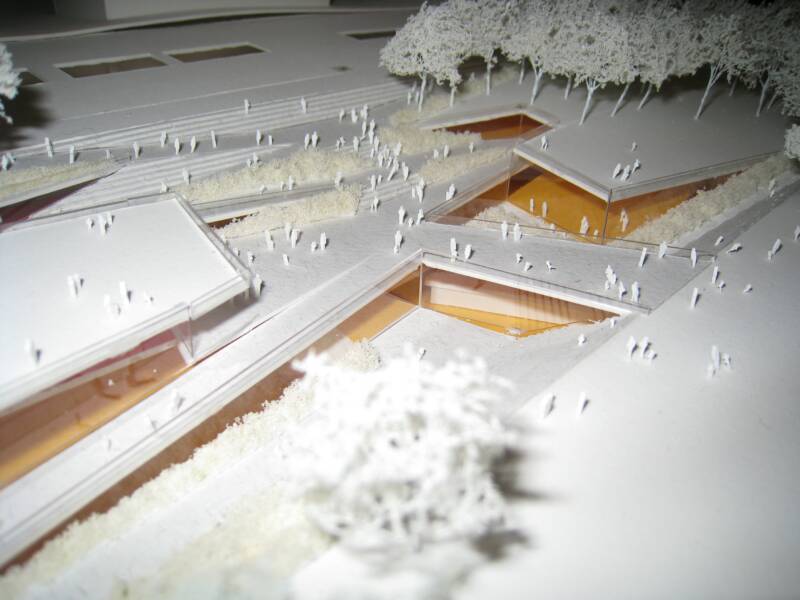Myth: Green space will be lost.
Fact: There will be no loss of green space under the proposal. The museum and a new state-of-the art field house will replace the Daley Bicentennial Plaza field house and the adjoining concrete plaza, which is badly in need of repair. The museum plan leaves room for such amenities as the ice rink and playground. Because it would be below grade and feature a green roof at street level, the museum would be well-integrated into the park and would preserve views of the park, city and lake.
Myth: The park would remain undisrupted without this proposal.
Fact: The Chicago Park District is planning a major construction project for the same part of the park beginning later this year. The roof for the parking garage under the park needs to be repaired. This requires the removal of the entire park space bounded by Columbus, Lake Shore Drive, Randolph and Monroe. The construction for the new Chicago Children’s Museum would be concurrent with the roof project.
Myth: The museum has refused to explore alternative sites.
Fact: The museum exercised due diligence before settling on the Daley Bicentennial location. No other location met the museum’s four core requirements as well as Daley Bicentennial Plaza:
• A central downtown location
• Easy access to public transportation from all corners of the city
• Access to green space
• Plentiful adjacent covered parking, important for families with young children
Chicago Children’s Museum’s desire is to serve as a gateway for children and families to discover the city’s other wonderful offerings, from museums to parks to downtown itself. This site achieves this important goal. In particular, it gives visitors from all over Chicago an opportunity to experience the city’s greatest lakefront park, which many of them never get to see. It also would help make Daley Bicentennial Plaza a year-round destination.
Myth: The kids are being buried in a dark underground space.
Fact: The new museum will in fact be brighter than the current museum location. In addition to featuring skylights, the design incorporates creative use of windows to illuminate the various below-ground floors and galleries.
Myth: The proposal is illegal under Illinois Supreme Court decisions.
Fact: The plan is in compliance with existing court decisions, and there is strong precedent for this type of proposal. Other projects have gone ahead legally in Grant Park since the decisions, including Daley Bicentennial Plaza itself, which was built in 1976 when that part of the park was converted from a surface parking lot and rail yards. At that time, a two-level parking structure and field house were built, with the park added on top of the roof for the combined structure.
Millennium Park serves as a shining example of how this type of proposal can actually improve the park, all within the law. A central criteria set forth by the Supreme Court is the issue of preserving views of the lakefront, which this proposal does.
Myth: This violates A. Montgomery Ward’s legacy.
Fact: This part of the park did not exist when Ward was alive. It was built in the 1970s from what had been landfill, railroad tracks and subsequently a ground-level, open-sky parking lot. Park experts believe this proposal meets the spirit of his and Daniel Burnham’s visions for the lakefront because it exposes more children from all neighborhoods to the park, and because the museum will be more sensitively integrated into the park than the current 1970s concrete field house and plaza.
As the authority on the lakefront, Lois Wille has noted, “Chicago Children’s Museum in Grant Park is compatible with the true sprit of Aaron Montgomery Ward’s and Daniel Burnham’s visions for a lakefront preserved for all the people of Chicago.”
Myth: The plan includes tall structures.
Fact: The tallest part of the proposal is an all-glass sculptural entrance on upper Randolph that will be less than 20 feet tall. The sculptural entrance is important because it will serve the museum, the existing parking garage and the park district field house, its elevator making that part of the park ADA-accessible for the first time. All other elements of the plan are lower than upper Randolph Street.
In comparison, the Harris Theater lobby next door is 39 feet above upper Randolph Street and the Pritzker Pavilion in nearby Millennium Park is 130 feet above ground.
Myth: The lesson from the book “Forever Open, Clear and Free: The Struggle for Chicago’s Lakefront” is that the museum does not belong in the park.
Fact: The author herself, Lois Wille, supports the museum’s relocation to Grant Park, based on the conclusions of her book. Ms. Wille, who also is the former editorial page editor of the Chicago Tribune, has stated publicly she resents the selective use of quotes from her book to justify opposing the museum’s proposal.
In a recent opinion piece in the Chicago Tribune, she wrote: “It’s time to cool the hot rhetoric and consider the facts.”
The facts about the proposal, she wrote, are: “[Grant Park] belongs to no single ward, no single group of residents…Any addition or subtraction must enhance its role as Chicago’s original ‘public ground,’ welcoming all the people of the city, whatever their race, age or economic status. The proposed Children’s Museum meets this test…. The museum will not rob Grant Park of green space or intrude on its vistas….it will replace the ugly, 12,000 square-foot concrete bunker that is the current field house…with a 20,000 square-foot, grass-topped [one]...a new Children’s Museum in Grant Park offers a unique opportunity to connect young children to the history of their city.”
Myth: The museum is only used by children from affluent parts of Chicago and the suburbs.
Fact: The museum caters to children from all parts of Chicago, with a special focus on isolated communities. The museum has 400 community partners across city neighborhoods, and routinely takes programs and exhibits on the road to various communities. In fact, nearly 10 percent of people exposed to museum programs are served through traveling community programs away from the museum itself.
Thirty percent of our visitors pay nothing at all, and many more pay greatly reduced rates. In addition to many free or subsidized programs for Chicago Public Schools, we offer free Mondays once a month and free Thursday nights every week. When off-site programs are taken into account, half of the people served by the museum pay nothing.
Fifty-two percent of museum visitors identify themselves as being African-American, Latino, Asian, Native American or of mixed race.
Myth: The museum will create local traffic congestion.
Fact: Traffic experts have determined, and the Chicago Department of Transportation has agreed, that there would be minimal impact on upper Randolph. In fact, the proposed site is uniquely suited to ensure efficient traffic management, as Randolph at that location offers three different levels: one for pedestrian access, one for school buses and taxis, and the lowest one for service vehicles. This will help ensure safety by keeping children away from traffic. Visitors with cars will access the site through the parking garage ramp on Columbus, not via Randolph.
Myth: The plan incorporates multiple for-profit restaurants.
Fact: As an amenity to visitors, the museum’s plan includes a café that will focus on a healthy and affordable menu, as well as areas to enjoy light snacks.
Myth: This amounts to rich people and corporations buying a piece of the park.
Fact: Chicago–including all of today’s great cultural institutions from the Adler Planetarium to the Art Institute to the Field Museum–was built on a long and proud tradition of civic and business leaders working together to make the city a better place to live. It is the same desire to contribute to the community that is driving this project, which includes not only the museum but a new 20,000 square-foot field house and gym. The museum will recognize a major donor, Allstate, in the same way that funders are recognized throughout Millennium Park. The Chicago Park District will naturally continue to serve as a steward for both the park and the field house.
Myth: Local taxpayers will be on the hook for the cost of the museum.
Fact: Funding for the new museum will come from philanthropic gifts by individuals, corporations, foundations and other sources.
Myth: This is a private museum.
Fact: Chicago Children Museum holds the same not-for-profit status as other cultural institutions such as the Art Institute or the Field Museum, and is run by a volunteer board of directors.
Myth: There is a requirement that museums in the park not charge admission.
Fact: Other museums in the park, including the nearby Art Institute, charge admission. Thirty percent of Chicago Children’s Museum visitors pay nothing at all. In addition, the museum’s admission cost for a family is well below the average for other Chicago museums.
Myth: There is little support for this proposal.
Fact: There is broad support for this proposal across Chicago’s neighborhoods. The All Chicago Children’s Museum Committee, which backs the proposal, counts members in every Chicago ward, and the museum has received support from hundreds of individuals
Myth: The museum is a glorified playground.
Fact: The museum is a nationally and internationally renowned cultural institution devoted to the understanding and advancement of child development and learning.
The museum offers a much-needed safe place to learn and play, and play is the way children learn best at very young ages. The National Science Foundation has recognized the museum as both a research institution and a place for science and math learning. The museum is a member of both state and national museum associations.
Experts in child development know the importance of rich, meaningful, concrete experiences in the early years—they lead to gains in language and concept development. They strengthen social relationships with family and peers; they help form attitudes about lifelong learning, and lead to school readiness. Unfortunately, many children do not have sufficient access to play environments that stimulate this vital development.
All of the exhibits, programs, and activities offered by Chicago Children’s Museum are developed specifically to encourage developmentally-appropriate learning, inquiry, and experimentation, and in many cases, reinforce the curriculum of the Chicago Public Schools. Every activity is specially designed to teach different skills to children at different stages of development. For example, our Skyline exhibit helps young children develop motor skills, while older children learn about engineering and physics.
Chicago Children's Museum also offers programs and resources for the important adults in children’s lives—educators, parents and caregivers—that respond to the needs and interests of young children.
Myth: The museum is going to serve liquor to visitors.
Fact: There will be no liquor for sale or liquor available in any way at the museum during museum hours. Chicago Children's Museum’s proposed amendment to the Planned Development would allow the museum to apply for a liquor license for functions that may occasionally be held outside of museum hours.
One of the first steps in creating the appearance of wide-support, is to create controversy with statements SUPPOSEDLY MADE BY THOSE OPPOSING the Children's Museum attempted land grab of historically and legally protected Grant Park land. None of the below "Myths" are supported by any quoted statements. Then mix in some unsupported half-truths...then state what you call "Fact" - again unsupported. That's what expensive hired guns do to "create" the appearance of "wide support", when in reality all the polls show that the citizens of Chicago can see the truth. This series of Myths and Facts were copied from the Children's Museum website on April 21, 2008:
On this side of the webpage the advisors to this website ( www.neweastside.org ) will attempt to respond to the "CCM created Myths" and "CCM version of Facts". We will try to reference links to independent sources, or actual public statements made by citizens and organizations attempting to preserve the protected front yard of Chicago.
CCM Created Fictitious Myths and Half-Facts
Referenced Accurate Responses
The proposed building will be 14 times the volume of the existing Daley Fieldhouse, and will obstruct the views of Lake Michigan as shown in these linked graphics - that were created by the CCM architect and then hidden from study by the public. http://neweastside.orgHIDDEN.html
The CCM is merely stating a nonexistent "myth", and then supposedly telling everyone what is not news. The Monroe Garage is one of the 4 Grant Park garages that have been leased to Morgan Stanley for 99 years, and the lease agreement requires Morgan Stanley to replace (within 5 years) the waterproof membrane that is leaking salt and rain water into the garage.
During the 9 meetings conducted by Alderman Reilly in 2007, the CCM officials admitted they had NOT studied ANY alternative sites. They had no 2nd, 3rd, 4th, 5th etc. choices - only Grant Park.
The CCM really wants a beautiful location with a glass wall of windows looking down the center-line of the most protected park in the Chicago region. They want to hold black-tie candle-lit dinners so that potential contributors will feel good (or obligated) to write larger checks to support the well-paid museum staff.
The CCM also wants to increase your real estate taxes so they can receive an estimated ONE MILLION DOLLARS every year as a "museum" in a park.
The majority of the indoor space will look up to the sky and not see the grass or trees, according to the recent graphic by the Chicago Tribune.
FACT: NO PROPOSED BUILDINGS IN GRANT PARK HAVE SURVIVED COURT CHALLENGES IN 172 YEARS. The Art Institute was NOT challenged by A. Montgomery Ward in 1891. And the challenge to the Harris/Pritzker building was never decided based on the dedication retrictions, and was quietly dismissed by Judge Green in January, 2000 because the plaintiff did not live adjacent to the building. And someone has stolen or destroyed all copies of the complaint from the court records, the city records, and the park district records. Who could be hurt by those "missing" documents?
The four Illinois Supreme Court decisions that are written in understandable plain English and can be read by you at: http://neweastside.org/DECISIONS.html
Before Montgomery Ward died in 1913, Lois Wille relates in her 1973 book, that he regretted not challenging the Art Institute. How would he feel today after they have expanded 7 times to fill an increasing portion of protected land, because of his omission. The protected land is too convenient for public officials and politically connected wealthy persons to resist.
The CCM admits that the plan includes illegal above-grade structures (buildings) that obstruct the view of Lake Michigan (that you reviewed in the HIDDEN PICTURES link above).
Remember, the Harris was never litigated or decided based on the 1836 or 1839 dedication restrictions or the Illinois Supreme Court Decisions in 1897, 1902, 1909, or 1911.
In her Sept. 2006 letter, Lois Wille based her assumption that the CCM was "legal" on the 1999 Boaz case, that was quietly dismissed and never decided based on the "dedications restrictive covenants" that have been upheld many times by the Illinois Supreme Court.
This is not a Myth: Everyone agrees that Grant Park "belongs" to all the citizens of Chicago, and is used by many visitors and all the citizens of the Chicago region.
The museum is used by some school groups and the families that can afford the $36.00 entry fee (for a family of 4), or the annual membership fee.
Note the careful wording, "When off-site programs are taken into account, half of the people served by the museum pay nothing.
Note, CCM omitted automobiles dropping off the children at the Upper Randolph Main Entrance Address..and then trying to navigate the very complicated directions to the parking entrance on Middle Columbus.
It is a fact that the application requests the authority to open multiple restaurants with liquor licenses. The museum director has stated she does not "plan" on using the authority during normal operating hours...but that could change with a change of directors.
The liquor license request signals the intention to serve adults (susposedly after hours) while enjoying the beautiful view down the centerline of Grant Park. That will tend to loosen the wallets of donors during the black-tie dinners of the wealthy and politically connected patrons.
The taxpayers will be supporting the operation of the museum in the park for an estimated $1 million per year forever !!
The museum lawyers should read the 4 Ward decisions that specifically apply to Grant Park, and count how many times the word "private" is mentioned.
Again, the 4 Illinois Supreme Court specifically refer to charging admission...CCM lawyers should read the law - and follow it.
Channel 11 kept track of calls and found that 96% were against CCM violating the 172 year covenant.
The Chicago Children's Museum does not meet the defination of a "museum".
It started as a glorified playground in the 1980"s...and has maintained that starting tradition.
Real museums have real collections...CCM has none.
The primary reason the "museum" tag was added when they moved to Navy Pier, was to increase the probability and and amount of donations to pay the salaries of the staff. People feel good about contributing to a "museum" as a cultural amenity to preserve our heritage. CCM does not fit that description.
The CCM proposed amendment to the Planned Development also "allows" the museum to apply for a liquor license DURING museum hours.
Page Visits
This page was last updated: June 10, 2008





CCM 5th Version - This is an admission that the first four versions violated the dedication restrictions, contrary to CCM pronouncements. Does this address all 5 legal requirements, or only partially one?
CCM starts off badly by trying to hide the 14 times greater volume behind the BP Bridge.
CCM moved the entry pavillion onto the sidewalk: another admission that their pronouncements for the last 3 years were wrong.
What's missing ? As always, the CCM "hired PR guns" are hiding the comparison of the existing 1/14th fieldhouse side view. So we have added an approximate outline in blue above.
Also missing is the word "Cab and Vehicle Drop-Off" at the CCM Main Entrance (their street address)
Prepared prior to the 5th Version Above.
QUESTION: Because this is a completely new design, should the 30-day legal notice requirement before the May 15th (1pm) Plan Commission hearing be reset to give the public time to absorb and find the still missing information? And is the fast-track through the Zoning Committee rumored to be on May 20th good open government?
In this 5th Version, the proposed buildings or obstructions above ground outlined in red would not survive a court challenge based on the legal precedent of all 4 Illinois Supreme Court decisions.
Why would the CCM Directors push the residential park fieldhouse further from the residents, and then plop their dinner-view (commercial facility) further from the visitors? It appears obvious to them that the best VIEW is down the centerline of the most protected and beautiful park in the Midwest.
For the "children", of course.
No wealthy and politically-connected adult donor would prefer to look across Columbus to the Millennium Park Bike Station.
Naming rights to insure a legacy and a good view, with your name on a "Director" parking space are powerful motivators.
And is it reasonable to separate the fieldhouse from the playground? Again the clout and the VIEW.
COMMERCIAL
COMMERCIAL
COMMERCIAL
RESIDENTIAL
RESIDENTIAL
RESIDENTIAL
COMMERCIAL
RESIDENTIAL
RESIDENTIAL
View of Traffic & Bike
Storage
Stunning Centerline View
COMMERCIAL
Built Without Challenge as a building.
RESIDENTIAL
360
400
155
340
PRU
AON
BCBS
Ent.
Ent.
<----------Building Hidden by BP Bridge--------------->
Ent.
Note the lack of any perspective graphics that would allow the public to see the front of this proposed illegal structure that is 14 times the volume of the existing fieldhouse that has been considered legal for 35 years.
Note the discrepancy between the graphics, where the Entrance below is further to the West, in relation to the BC building.
Note that the BP Bridge in this graphic is hiding the existing green grass. Certainly a cute PR trick to pretend that the 14 times larger building just "replaces an existing building", as CCM officials claim.
Approx. middle of BC building
It is difficult to drive from Main Entrance to Garage Entrances.
<--Gar.Ent.
Gar.Ent.--->
Note the "Ent." The above CCM graphic from their website is only the Eastern HALF of the building !!
Proposed Fieldhouse Relocation
Existing Playground Proposed to be Remote from Fieldhouse.
Upper Ran.
Middle Col.
Turns out that the Children’s Museum that says they want to serve all of Chicago doesn’t feel as compelled to have all of Chicago on their board of directors. We've identified the home addresses of 32 of the museum’s 41 board members. Here are some examples:
Chicago’s West Side: 0
Chicago’s South Side: 1
Board Chairman’s Zip (60614): 11
North Shore Suburbs: 6

This is a model of the 5th Version that was revealed to the public just a few days prior to the Plan Commission hearing. Each version has been an admission by the Children's Museum managers and board leadership that they were not telling the truth that the last version was completely within the legal limitations of the dedication restrictions and the Illinois Supreme Court Decisions. In keeping with this pattern of behavior, this 5th Version is "less illegal".
Upper Randolph
<----- Main Entrance (on sidewalk)...the start of a VERY COMPLEX ROUTE to parking on Middle Columbus !!!
Dozens of Steps
Anything above this GROUND surface of the Daley Plaza violates the dedication restrictions and four Illinois Supreme Court Decisions.
Also the pay-for-play fees charged for entry to this private building on protected park land is a further violation that no court has tolerated IN THE HISTORY OF CHICAGO..
